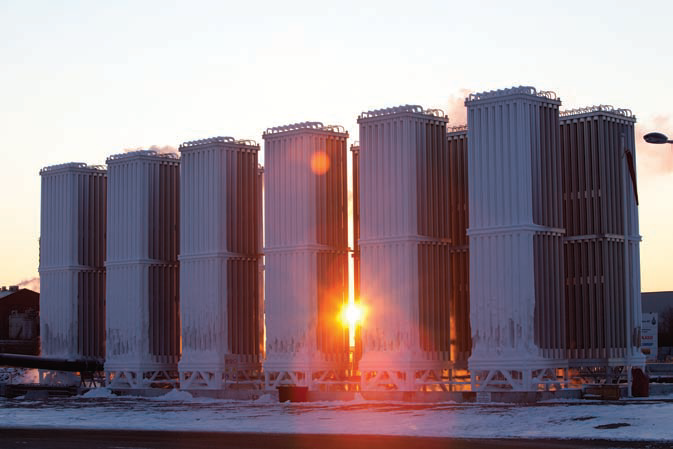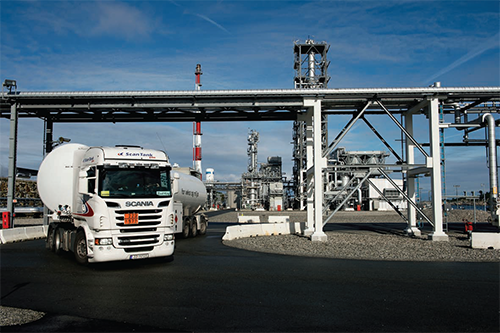
Skangass AS: A Rising Star in Norway’s Liquefaction Scene, as Featured in European Oil and Gas Magazine
A future market
When it was last featured in European Oil and Gas Magazine during April 2010, Skangass AS was a young company jointly owned by Lyse AS and Celsius Invest AS and was in the final stages of competing its solid liquefaction plant in Risavika, in the Sola region of Norway.
Three years later and LNG production at the plant is underway and it is able to produce 300,000 tonnes of LNG annually after its official opening during October 2011. Further to this major development in the company’s history, Skangass has also had its ownership fully transferred to Lyse AS, which now owns 100 per cent of the business. Lyse AS acquired 32.9 per cent of Skangass from Celsius after both parties agreed that the transfer of ownership was the best route for the development of the company. Lyse is currently owned by a group of 16 municipalities of Stavanger, where the company is currently headquartered, with Stavanger Kommune controlling a 43.68 per cent stake in the business.
The completion of its LNG terminal plant has enabled Skangass to become the leader in small to mid-scale LNG supply within the Norwegian and Swedish marketplace. “The Stavanger plant is the second largest LNG power plant in Europe and has a production capacity of over 300,000 tons of LNG per year, which equals 4.5 kilowatt hours,” sales and marketing director Roger Gothberg elaborates. “Since we went into production we have developed the infrastructure to provide LNG to the Norwegian and Swedish markets. Our main focus has been on the industrial sector, typically metal producers, the pulp and paper industries, chemical industries and refineries. To service these markets we built a new hub terminal in a city called Fredrikstad, which is right at the border between Sweden and Norway on the Norwegian side. This hub terminal serves a local gas grid to industrial customers, as well as a being a loading point for LNG trucks delivering into the eastern part of Norway and the western part of Sweden. So far we are quite a young company and we have mainly, although not exclusively, been active in Sweden and Norway. Our mission for the future is to become the market leader in Northern Europe for delivering small-scale LNG supply to the industrial and marine sectors.”
The Fredrikstad terminal came into operation during Summer 2011 and the company has acquired 16 LNG trailers to support the logistical aspect of its operation. Further to this, Skangass has a charter with Dutch ship owner Anthony Vader for a brand new LNG vessel called Corel Energy. A second, smaller vessel, the Coral Anthelia, will be taken into operation in October 2014. To further expand its reach within the Swedish market, Skangass has entered into an agreement with Sweden’s second largest oil company, Preem, to supply LNG to its refinery in Lysekil. To service the agreement Skangass is in the process of constructing a 55 million Euro LNG terminal to supply the refinery. Skangass will supply the facility with 150,000 tonnes of liquefied natural gas a year, which is expected to reduce the facilities CO2 output by 130,000 tonnes per year.
 LNG is becoming an increasingly popular answer to Europe’s energy needs. From an industry perspective LNG offers a number of benefits to clients including lower operating costs, better efficiency, lower maintenance costs, better availability, a cleaner working environment and reduced environmental taxes. Owing to the numerous benefits of using LNG as an energy source, operators are increasingly turning to LNG to power their businesses. “Recently, Skangass entered into a long-term agreement with the Swedish company SSAB EMEA to supply LNG for its facility in Borlänge, Sweden,” Roger explains. “SSAB is a steel metal producer and they have facilities in three locations in Sweden. Skangass will supply LNG to the Borlänge location. The company has two ovens at this facility, one of them is running on LPG and the other one is using heavy fuel oil. What we are doing is changing the heavy fuel oven over to natural gas. We have now starting to build the receiving terminal at the site to receive LNG and SSAB is planning the conversion of the oven and that will be ready at the end of next year, so we will begin supplying from either November or December 2014.
LNG is becoming an increasingly popular answer to Europe’s energy needs. From an industry perspective LNG offers a number of benefits to clients including lower operating costs, better efficiency, lower maintenance costs, better availability, a cleaner working environment and reduced environmental taxes. Owing to the numerous benefits of using LNG as an energy source, operators are increasingly turning to LNG to power their businesses. “Recently, Skangass entered into a long-term agreement with the Swedish company SSAB EMEA to supply LNG for its facility in Borlänge, Sweden,” Roger explains. “SSAB is a steel metal producer and they have facilities in three locations in Sweden. Skangass will supply LNG to the Borlänge location. The company has two ovens at this facility, one of them is running on LPG and the other one is using heavy fuel oil. What we are doing is changing the heavy fuel oven over to natural gas. We have now starting to build the receiving terminal at the site to receive LNG and SSAB is planning the conversion of the oven and that will be ready at the end of next year, so we will begin supplying from either November or December 2014.
“The conversion will reduce the facility’s emissions substantially. Industries have a cap on how much they can pollute each year so by converting to natural gas SSAB can increase its production because they will be releasing fewer emissions. LNG is a double benefit for the company.”
As well as allowing an increase in output across various sectors, LNG is an environmentally responsible alternative to more traditional fossil fuels, as Roger observes: “Natural gas is the best sort of fuel that you can find in the world. If you look at the environmental aspect you will never find a fossil fuel that is as good for the environment as natural gas. It has many positives on the production side because it is a very clean energy. CO2 is one reduction you have with natural gas, when it is used instead of oil products, but better still is the fact that the sulphur content is basically zero. There are no particals and NOx emissions will be greatly reduced when more natural gas is used instead of oil product. It works very well for the kind of industrial customer that we attract. The next benefit is that once you have invested in a structure that can use natural gas, you have invested in a structure that can use biogas, which is renewable and a very positive product to use from an environmental perspective. Also you are not investing in infrastructure that will be useless in the future, it will definitely have applications in the years ahead.”
Currently Skangass employs around 50 people, but the company expects to grow in the near future as LNG becomes an ever more relied upon energy source. The company has a pioneering lead in northern Europe’s emerging LNG market and it is keen to expand its expertise as it moves into new areas, as Roger concludes: “We are a young organisation but still have a lot of experience, especially here in Stavanger because we basically built the company and a majority of our staff have been here since the beginning. Of course we benefit from that when we introduce new people to the organisation. It is important that we use the competence that we have built up in quite a short time and we have learned a lot over the past few years that will help us advance into new areas of LNG. It is important that we pass that knowledge over to new members of the team.
“I would say that LNG is in the hype if you like. It will be an energy source that will be used much more in the future, particularly in the marine market, so the future looks very promising.”
Skangass AS
Services: LNG production and supply